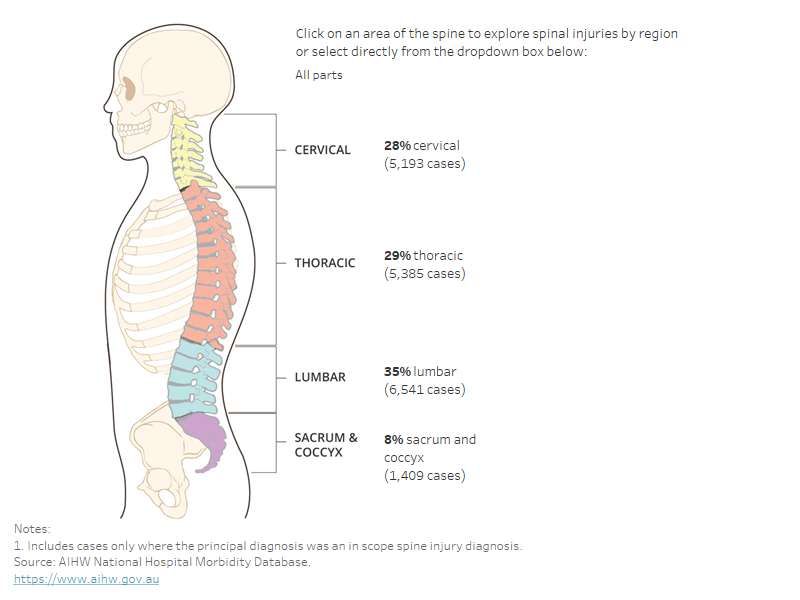Part of spine injured
The lumbar region emerged as the most frequently affected spinal region in injury hospitalisations where spinal injury was the principal diagnosis, while the cervical spine was the predominant site of injury in ED presentations (Table 5). Perceived increased severity of cervical spinal injuries may lead to overrepresentation of this type of injury in ED presentations, as compared to injuries of other parts of the spine.
Table 5: Top 3 specified spinal regions of spinal injury, 2020–21
Spinal injury ED presentations | n | Rate per 100,000 | % | Spinal injury hospitalisations | n | Rate per 100,000 | % |
|---|---|---|---|---|---|---|---|
Cervical | 8,476 | 33.0 | 44 | Lumbar | 6,541 | 25.5 | 34 |
Thoracic | 5,188 | 20.2 | 27 | Thoracic | 5,385 | 21.0 | 28 |
Lumbar | 4,304 | 16.8 | 22 | Cervical | 5,193 | 20.2 | 27 |
Source: AIHW National Hospital Morbidity Database (NHMD) and AIHW National Non-admitted Patient Emergency Department Care (NNAPEDC) Database
Across spinal regions, rates of ED presentations varied by age
In 2020-21:
- In the cervical spine region, the highest rate of spinal injury ED presentations were among those aged 15-24 (50.1 per 100,000).
- In the thoracic, lumbar and sacrum spine regions, the highest rate of spinal injury ED presentations were among those aged 65 and over (38.9, 48.6 and 0.8 per 100,000).
- In the coccyx spine region, the highest rate of spinal injury ED presentations were among those aged 45-64 (0.4 per 100,000).
The lumbar region was most commonly injured in spinal injury hospitalisations
The lumbar region was the most commonly injured spinal region for both males and females, contributing to 1 in 3 (34% or 6,541 cases) of spinal injury hospitalisations where spinal injury was the principal diagnosis.
For most spinal regions, the rate of injury increased with age, and varied by sex. Notable difference in the distribution of spine region injury types within each sex were:
- Males had a higher proportion of cervical injuries than females (31% or 3,080, and 23% or 2,113 cases respectively).
- Females had a higher proportion of lumbar and sacral injuries than males (36% or and 33%, compared to 10% and 3% respectively).
Differences in primary diagnoses for spinal injury hospitalisations by sex were:
- Fracture of lumbar vertebra, L1 level was the leading diagnosis, followed by Fracture of lumbar vertebra, L2 level for males and Fracture of sacrum for females.
- Sacral spinal injuries were diagnosed 2 times more often in females than in males.
Figure 7: Number/percentage of hospitalisations for spinal injuries, by spine region, 2020–21
An interactive spine region visualisation showing top three most common injury types and causes by spine region for hospitalisations. The visualisation shows the leading specified location for spinal injuries was for the lumbar region.



